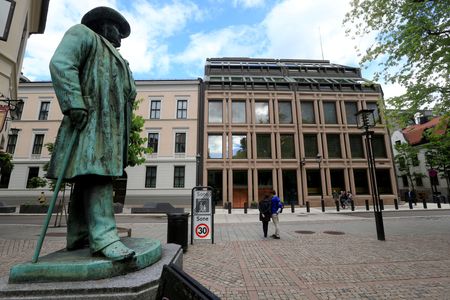
LONDON (Reuters) – Norway and Sweden have joined the ranks of central banks opting for 50 basis-point interest rate rises, delivering their biggest policy tightening moves in two decades.
June saw the U.S. Federal Reserve upping rates by 75 basis points and the Swiss National Bank surprise with a half-point hike. That means the Bank of Japan is the only major developed world central bank still chanting the inflation-is-transitory mantra.
Here’s a look at where policymakers stand in the race to contain inflation.
1) UNITED STATES
The Federal Reserve vaulted to the top-hawk spot on June 15, raising the target federal funds rate by three quarters of a percentage point to a 1.5%-1.75% range.
It acted days after data showed 8.6% annual U.S. inflation, triggering a market frenzy over potentially even more aggressive responses in the coming months.
The Fed is also reducing its $9 trillion stash of assets accumulated during the pandemic.
2) NEW ZEALAND
The Reserve Bank of New Zealand raised its official cash rate by 50 basis points (bps) to 2% on May 25, a level not seen since 2016. That was its fifth straight rate hike.
It projected rates to double to 4% over the coming year and stay there until 2024. New Zealand inflation reached a three-decade high of 6.9% in the year to Q1, versus a 1-3% target.
3) CANADA
The Bank of Canada delivered a second consecutive 50 bps rate increase to 1.5% on June 1, and said it would “act more forcefully” if needed.
With April inflation at 6.8%, Governor Tiff Macklem has not ruled out a 75 bps or larger increase and says rates could go above the 2%-3% neutral range for a period.
Deputy BoC governor Paul Beaudry has warned of “galloping” inflation and markets price an unprecedented third consecutive 50 bps increase in July.
4) BRITAIN
The Bank of England (BoE) raised interest rates by 25 bps on June 16, its fifth rate rise since December, taking rates to 1.25% — the highest since January 2009.
Given that it sees UK inflation heading above 11%, it might well have to fulfil its promise to act “forcefully” if needed.
5) NORWAY
Norway, the first big developed economy to kick off a rate-hiking cycle last year, raised rates by 50 bps on June 23 to 1.25%, its largest single hike since 2002.
The Norges Bank plans to raise rates by 25 bps at each of its four remaining policy meetings in 2022, although larger increments are also possible, Governor Ida Wolden Bache said.
6) AUSTRALIA
With the economy recovering smartly and inflation at a 20-year high of 5.1%, the Reserve Bank of Australia (RBA) raised rates by a surprise 50 bps on June 6. It was the RBA’s second straight move after insisting for months policy tightening was way off.
Money markets price in another 50 bps rise in July.
7) SWEDEN
Another late-comer to the inflation battle, Sweden’s Riksbank delivered a half percentage point interest rate hike on June 30 to 0.75%.
The move was Sweden’s biggest in more than 20 years.
As recently as February, the Riksbank had forecast unchanged policy until 2024, but governor Stefan Ingves now expects rates to hit 2% in early-2023 and said 75 bps moves are possible.
8) EURO ZONE
With euro zone inflation hitting 8.6% in June, the European Central Bank (ECB) will raise interest rates by 25 bps on July 21 for the first time since 2011 and again in September .
The bank is also accelerating work on a tool to contain bond market fragmentation within the bloc. From July 1 it will also use proceeds from maturing German, French and Dutch bonds to buy debt from weaker markets such as Italy .
9) SWITZERLAND
On June 16, the Swiss National Bank (SNB) unexpectedly raised its -0.75% interest rate, the world’s lowest, by 50 bps, sending the franc soaring.
Recent franc weakness has contributed to driving Swiss inflation towards 14-year highs and SNB governor Thomas Jordan said he no longer sees the franc as highly valued. That has opened the door to bets on more rate hikes; a 100 bps move is now priced for September.
10) JAPAN
That leaves the Japan as the holdout dove.
On June 18, it maintained ultra-low interest rates and vowed to defend its cap on bond yields with unlimited bond-buying. It holds 10-year yields in a 0%-0.25% range .
BoJ boss Haruhiko Kuroda stressed commitment to maintaining stimulus though, in a nod to yen weakness, Kuroda called its rapid decline to 24-year lows “undesirable” as it heightened uncertainty.
Hedge funds, meanwhile, are betting it can’t maintain huge bond-buying for ever. The BoJ may also face political pressure, given inflation may exceed the 2% target for the second straight month and elections loom in July.
(This story refiles with updated chart, adds BoE chart)
(Reporting by Sujata Rao, Dhara Ranasinghe and Yoruk Bahceli; Additional reporting by Tommy Wilkes and Saikat Chatterjee; Editing by Mark Potter and Andrew Heavens)

